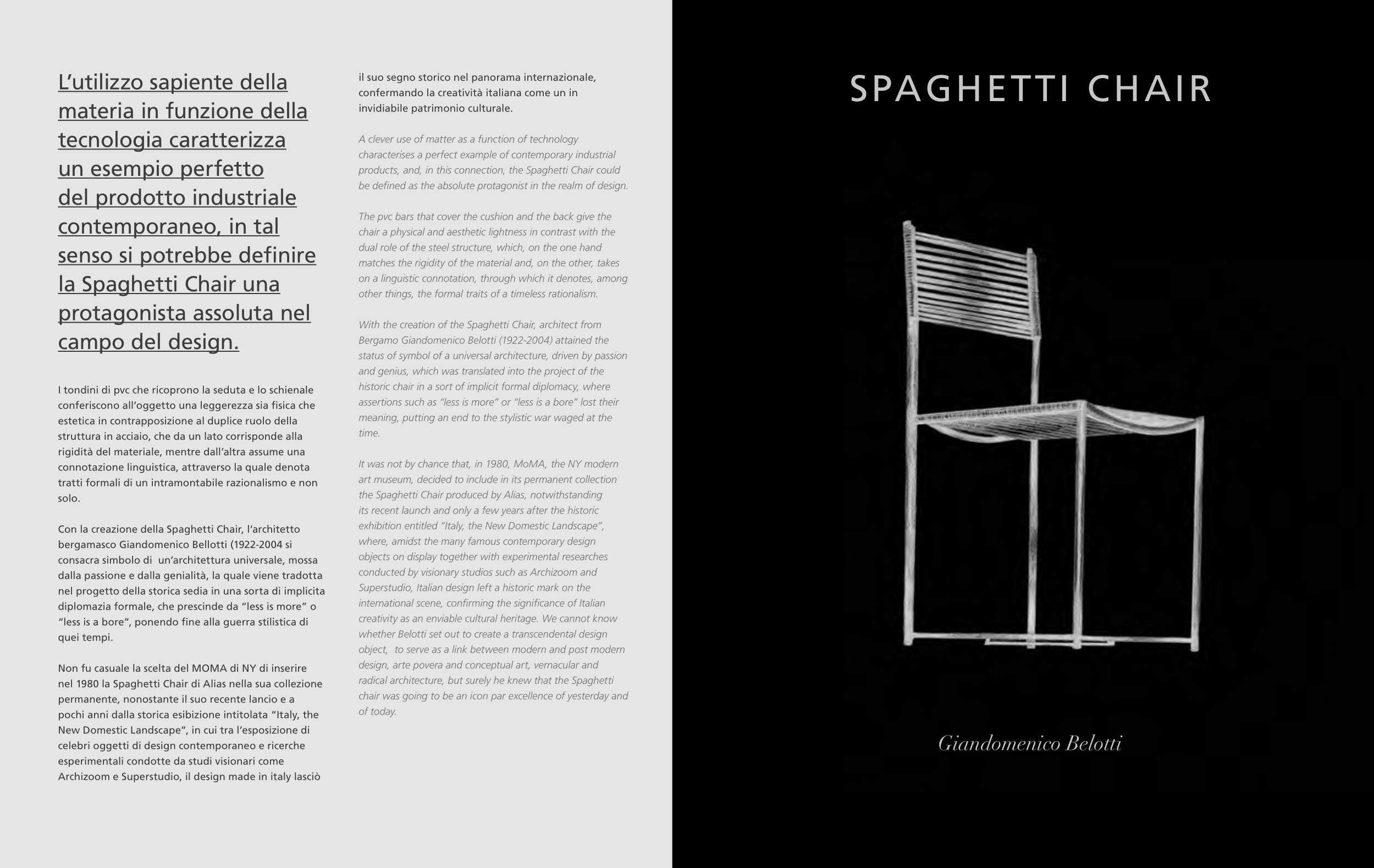L’utilizzo sapiente della
materia in funzione della
tecnologia caratterizza
un esempio perfetto
del prodotto industriale
contemporaneo, in tal
senso si potrebbe definire
la Spaghetti Chair una
protagonista assoluta nel
campo del design.
I tondini di pvc che ricoprono la seduta e lo schienale
conferiscono all’oggetto una leggerezza sia fisica che
estetica in contrapposizione al duplice ruolo della
struttura in acciaio, che da un lato corrisponde alla
rigidità del materiale, mentre dall’altra assume una
connotazione linguistica, attraverso la quale denota
tratti formali di un intramontabile razionalismo e non
solo.
Con la creazione della Spaghetti Chair, l’architetto
bergamasco Giandomenico Bellotti (1922-2004 si
consacra simbolo di un’architettura universale, mossa
dalla passione e dalla genialità, la quale viene tradotta
nel progetto della storica sedia in una sorta di implicita
diplomazia formale, che prescinde da “less is more” o
“less is a bore”, ponendo fine alla guerra stilistica di
quei tempi.
Non fu casuale la scelta del MOMA di NY di inserire
nel 1980 la Spaghetti Chair di Alias nella sua collezione
permanente, nonostante il suo recente lancio e a
pochi anni dalla storica esibizione intitolata “Italy, the
New Domestic Landscape”, in cui tra l’esposizione di
celebri oggetti di design contemporaneo e ricerche
esperimentali condotte da studi visionari come
Archizoom e Superstudio, il design made in italy lasciò
il suo segno storico nel panorama internazionale,
confermando la creatività italiana come un in
invidiabile patrimonio culturale.
A clever use of matter as a function of technology
characterises a perfect example of contemporary industrial
products, and, in this connection, the Spaghetti Chair could
be defined as the absolute protagonist in the realm of design.
The pvc bars that cover the cushion and the back give the
chair a physical and aesthetic lightness in contrast with the
dual role of the steel structure, which, on the one hand
matches the rigidity of the material and, on the other, takes
on a linguistic connotation, through which it denotes, among
other things, the formal traits of a timeless rationalism.
With the creation of the Spaghetti Chair, architect from
Bergamo Giandomenico Belotti (1922-2004) attained the
status of symbol of a universal architecture, driven by passion
and genius, which was translated into the project of the
historic chair in a sort of implicit formal diplomacy, where
assertions such as “less is more” or “less is a bore” lost their
meaning, putting an end to the stylistic war waged at the
time.
It was not by chance that, in 1980, MoMA, the NY modern
art museum, decided to include in its permanent collection
the Spaghetti Chair produced by Alias, notwithstanding
its recent launch and only a few years after the historic
exhibition entitled “Italy, the New Domestic Landscape”,
where, amidst the many famous contemporary design
objects on display together with experimental researches
conducted by visionary studios such as Archizoom and
Superstudio, Italian design left a historic mark on the
international scene, confirming the significance of Italian
creativity as an enviable cultural heritage. We cannot know
whether Belotti set out to create a transcendental design
object, to serve as a link between modern and post modern
design, arte povera and conceptual art, vernacular and
radical architecture, but surely he knew that the Spaghetti
chair was going to be an icon par excellence of yesterday and
of today.
SPAGHETTI CHAIR
Giandomenico Belotti







